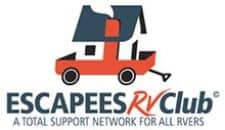Have you got the itch to travel? Tired of seeing the same thing outside your windows every single day?
Easy. Get an RV.
“Easy,” he says, as if there aren’t 14 zillion different options for recreational vehicles out there.
How do you decide which one to buy? It can feel overwhelming, but this guide will help.
We’ll start with the premise that you’ve decided you don’t want to have to leave your vehicle to get to your living space. (This is a big consideration for solo female travelers, especially.) If you’re woken up in the wee hours of the morning by some sketchy folks messing with your camper, you want to be able to go from bed to driver’s seat without stepping outside.
Stranger danger aside, it also sucks when the weather is nasty and your only option is to track it all into your camper.
Now that we’ve eliminated travel trailers and fifth wheels, let’s look at the single-unit RVs. There are three: Class A, Class B, and Class.
(You may also run into designations of “Class B+” or “Super C”, but these labels are more marketing-ese than anything else. A Class B+ is basically a Class C, and the Super Cs are small Class A vehicles.)
Do you have a huge family? Want every single amenity? Don’t mind getting abysmal gas mileage? Have no plans to ever leave wide paved roads? Great! Go with the Class A coach. Enjoy your bus. And the Interstate.
That leaves the Class Bs and Class Cs. So what’s the difference?
CLASS B RVS: THE CONVERSION VAN

Class B campers are built on a commercial van chassis. The most popular chassis models are Mercedes Sprinter, Ford Transit, and Dodge Ram ProMaster. In general, they range from 16 feet to 24 feet in total length. They also get pretty good gas mileage.
Class B Amenities
While these will obviously be tinier versions than the ones found in larger campers, you can generally expect to see:
- A bed that converts to seating/dining or folds out of the way
- A small cooktop, possibly with an oven or microwave
- A sink and refrigerator
- A toilet, possibly within a shower stall (called a wet bath)
- A few drawers and cabinets for storage
Most custom van conversions – the kind you’ll find with the #vanlife tag on Instagram – have a queen-size bed mounted on a platform at the back of the vehicle, with the space underneath serving as a “garage.” This garage may only be accessible through the back doors, though some beds might lift up.
Class B Pros
- Easier maneuverability
- Can fit in standard parking spaces
- More off-road capabilities
- More campground options
- Cheaper to fill the fuel tank
Class B Cons
- Little to no exterior storage
- Very limited interior storage
- Smaller fresh and black/gray water tanks
- Sinks are often too small to easily wash pots and pans
- Limited to 1-2 people
Here are two examples of a Class B floorplan:

This is the Winnebago Travato 59G. You can see by the dotted lines that there isn’t a whole lot of storage. The bed folds up against the wall to allow access to a little bit more space, though some of that is taken up by water and power components.

This is the Winnebago Travato 59K. You can see that the wet bath has been moved to the back of the vehicle, and also doubles as your closet. The beds can be left separate or converted to a larger single. There’s more upper cabinet storage, but you lose the bigger refrigerator and the extra seating.
Despite their small size, there are many different designs for Class B vans. These two were chosen to illustrate the major differences in the available layouts and amenities, even between two models from the same manufacturer.
CLASS C RVS: THE CLASSIC PROFILE

Class C campers are built on a truck chassis and have the distinctive “cab-over”, which is the overhang above the front of the vehicle. This is usually used as an extra sleeping space, but can also be storage. Class Cs are a very popular choice because they are more maneuverable than a Class A, but have more space and storage than a Class B.
Class C Amenities
Having extra space means you won’t have to skimp on some things.
- Multiple beds, some of which won’t need to be converted
- The primary bedroom can usually be closed off for more privacy
- More and larger appliances
- Much more internal and external storage space
- Dry bath (toilet and shower are separate)
There is a lot of variety in Class C floorplans (see below). You won’t have to worry about every square inch, but you will need to do some comparing to get the layout that works best for your family.
Class C Pros
- Larger engine provides more towing capacity
- Can comfortably sleep up to 6 people (depending on the floorplan… and the people)
- Larger tanks for water and propane
- Slide-outs provide expanded living spaces
- As easy to drive as a moving van (think U-Haul)
Class C Cons
- Some areas prohibit parking Class Cs in residential areas
- Not as fuel-efficient as Class B vans
- May not fit in every campsite
- In many designs, the driver and passenger seats do not rotate to become part of the living space
- The suspension may not be very robust, leading to a slightly rougher ride
Here are three examples of a Class C floorplan:

This is the Thor Compass. It is one of the smaller Class Cs, perfect for one or two travelers who want the extra space, but don’t need all of the amenities. Note that the kitchen layout is identical to many Class Bs. The slide-out on the left of the vehicle allows for more living space, a larger bedroom, and a dry bath.

This is the Jayco Redhawk. Again, a slide-out opens up the space dramatically, and allows for separate dining and living room seating. The kitchen has more amenities, including a residential double sink, and the dry bath has two access doors.

This is the Coachman Freelander 30BH. It has a slide-out on both sides, delivering a huge amount of space. It has a compact kitchen, two dinette seats, a separate sofa, even two nightstands in the primary bedroom.
There are literally hundreds of floorplans available for Class C vans. If you have a large family, or entertain a lot, this may be the right RV for you.
BEFORE YOU BUY!
Choosing between a Class B and a Class C RV is dependent on more than how many people are going. It also means identifying and prioritizing the things that are important to you.
- What stuff can you just not live without? Where will you put it all?
- What daily activities take up most of your time? Are they indoors or outdoors?
- What are your passions? Do they require specialized equipment?
- Do you want to have to break down and set up your bed every single day so you can have seating or dining areas?
- How often do you want to grocery shop?
- How often do you want to use a laundromat?
- Will you boondock the majority of the time or stay at campgrounds?
When you have some answers, that will help narrow down your choices.
One example: If you love to cook, ask yourself these things:
- What equipment you need to prepare your favorite recipes?
- Do you have to have an oven? A gas cooktop?
- How large a refrigerator and/or freezer will you need?
- Do you have any specialized countertop appliances?
- Will you need storage space for 60 different spices and 4 kinds of flour?
- How many drawers will you need for utensils?
- What will you do with leftovers?
- How many sets of dishware will you need?
- Are you prepared to wash everything by hand? Where will you keep the sponges and soap?
Once you think you know what you want, that’s the time to start checking RVs out in person!
- Walk around the space, stretch out on the bed, sit in every seat.
- If possible, rent that same model of RV for a week or so (don’t make these mistakes!) to experience it in real-world conditions. Ask the salesman this list of questions!
- You’ll have a much better idea of how that layout will work for you.
Traveling in an RV can be a lot of fun, no matter if you’re doing it full-time or just the occasional long weekend or summer trip. Sure, there will be moments of frustration and second-guessing, but that’s just life.
With some detailed forethought, good prepping, and clear expectations, you can pick the right RV to minimize the annoyances and maximize the adventure!









